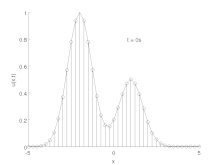Method of lines
The method of lines (MOL, NMOL, NUMOL[1][2][3]) is a technique for solving partial differential equations (PDEs) in which all but one dimension is discretized. MOL allows standard, general-purpose methods and software, developed for the numerical integration of ODEs and DAEs, to be used. Many integration routines have been developed over the years in many different programming languages, and some have been published as open source resources.[4]

The method of lines most often refers to the construction or analysis of numerical methods for partial differential equations that proceeds by first discretizing the spatial derivatives only and leaving the time variable continuous. This leads to a system of ordinary differential equations to which a numerical method for initial value ordinary equations can be applied. The method of lines in this context dates back to at least the early 1960s.[5] Many papers discussing the accuracy and stability of the method of lines for various types of partial differential equations have appeared since.[6][7]
Application to elliptical equations
MOL requires that the PDE problem is well-posed as an initial value (Cauchy) problem in at least one dimension, because ODE and DAE integrators are initial value problem (IVP) solvers. Thus it cannot be used directly on purely elliptic partial differential equations, such as Laplace's equation. However, MOL has been used to solve Laplace's equation by using the method of false transients.[1][8] In this method, a time derivative of the dependent variable is added to Laplace’s equation. Finite differences are then used to approximate the spatial derivatives, and the resulting system of equations is solved by MOL. It is also possible to solve elliptical problems by a semi-analytical method of lines.[9] In this method, the discretization process results in a set of ODE's that are solved by exploiting properties of the associated exponential matrix.
Recently, to overcome the stability issues associated with the method of false transients, a perturbation approach was proposed which was found to be more robust than standard method of false transients for a wide range of elliptic PDEs.[10]
References
- Schiesser, W. E. (1991). The Numerical Method of Lines. Academic Press. ISBN 0-12-624130-9.
- Hamdi, S.; W. E. Schiesser; G. W. Griffiths (2007), "Method of lines", Scholarpedia, 2 (7): 2859, doi:10.4249/scholarpedia.2859
- Schiesser, W. E.; G. W. Griffiths (2009). A Compendium of Partial Differential Equation Models: Method of Lines Analysis with Matlab. Cambridge University Press. ISBN 978-0-521-51986-1.
- Lee, H. J.; W. E. Schiesser (2004). Ordinary and Partial Differential Equation Routines in C, C++, Fortran, Java, Maple and Matlab. CRC Press. ISBN 1-58488-423-1.
- E. N. Sarmin; L. A. Chudov (1963), "On the stability of the numerical integration of systems of ordinary differential equations arising in the use of the straight line method", USSR Computational Mathematics and Mathematical Physics, 3 (6): 1537–1543, doi:10.1016/0041-5553(63)90256-8
- A. Zafarullah (1970), "Application of the Method of Lines to Parabolic Partial Differential Equations With Error Estimates", Journal of the Association for Computing Machinery, 17 (2), pp. 294–302, doi:10.1145/321574.321583
- J. G. Verwer; J. M. Sanz-Serna (1984), "Convergence of method of lines approximations to partial differential equations", Computing, 33 (3–4): 297–313, doi:10.1007/bf02242274
- Schiesser, W. E. (1994). Computational mathematics in Engineering and Applied Science: ODEs, DAEs and PDEs. CRC Press. ISBN 0-8493-7373-5.
- Subramanian, V.R.; R.E. White (2004), "Semianalytical method of lines for solving elliptic partial differential equations", Chemical Engineering Science, 59 (4): 781–788, doi:10.1016/j.ces.2003.10.019
- P. W. C. Northrop; P. A. Ramachandran; W. E. Schiesser; V. R. Subramanian (2013), "A Robust False Transient Method of Lines for Elliptic Partial Differential Equations", Chem. Eng. Sci., 90, pp. 32–39, doi:10.1016/j.ces.2012.11.033
External links
| The Wikibook Partial Differential Equations has a page on the topic of: Method of Lines |